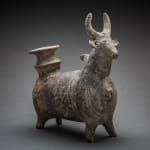Terracotta Aquamanile in the Shape of a Bull, 400 CE - 600 CE
Buff Terracotta
21 x 22.9 cm
8 1/4 x 9 in
8 1/4 x 9 in
LO.851
Zoomorphic water vessel made of terracotta in the shape of a bull standing foursquare with dark brown slip over whole, incised and moulded decoration; stout body of tapering cylindrical form...
Zoomorphic water vessel made of terracotta in the shape of a bull standing foursquare with dark brown slip over whole, incised and moulded decoration; stout body of tapering cylindrical form with blunt rear at one end giving rise to applied filling-spout and short, rounded tail; applied, pierced breastplate at other end rising through broad, triangular neck to narrow, angular head flanked by laterally protruding ears and topped by twin horns; incised eyes and circle to apex of horns. From ACE 390 onwards, the Land of Israel and Judah became a part of the Eastern Roman Empire known as the Byzantine Empire, which would endure until ACE 611. This piece marks the span of a period heavily shaped and defined by a Christian majority, the result of mass Christian migration into the Roman province of Palestine following the collapse of the Western Roman Empire in 5th century ACE.
The force of tradition in Byzantine art is great. That forms, processes and techniques stem from the depths of Antiquity is irrefutable. Constantinople, capital of the Byzantine Empire and hub of world culture was connected by its very location to both Greece and Central Asia. It was in constant commercial and political contact with the most powerful dynasties of the East, particularly Persia. In the arts, we see influence across a vast area that incorporates both Greek and Eastern influence, which is appreciable at every turn. The aquamanile was brought into the Christian Mediterranean world through the Byzantine Empire’s cultural connections with Sassanid Persia. Though the origins of the vessel can actually be traced outside Mesopotamia to ancient Cyprus. We have excellent examples of comparable bull-shaped water vessels used for hand washing known as rythons dating 1550 BCE, which similarly bear rotund, stout bodies and short legs. Close contact with the Aegean and Mycenaean settlement in 1230 BCE resulted in the gradual hellenization of Cyprus and synthesis of cultures. Intermittent periods of Persian rule from 8th century onwards connected Cyrus and Persia. One begins to form an impression of the spread of influences throughout the ancient world at this time. However, rather than combine diverse elements, artisans proved truly innovative and made appropriated forms their own. Used to store water for hand washing over a basin, which was a part both of upper-class meals and the Christian Eucharist.
The force of tradition in Byzantine art is great. That forms, processes and techniques stem from the depths of Antiquity is irrefutable. Constantinople, capital of the Byzantine Empire and hub of world culture was connected by its very location to both Greece and Central Asia. It was in constant commercial and political contact with the most powerful dynasties of the East, particularly Persia. In the arts, we see influence across a vast area that incorporates both Greek and Eastern influence, which is appreciable at every turn. The aquamanile was brought into the Christian Mediterranean world through the Byzantine Empire’s cultural connections with Sassanid Persia. Though the origins of the vessel can actually be traced outside Mesopotamia to ancient Cyprus. We have excellent examples of comparable bull-shaped water vessels used for hand washing known as rythons dating 1550 BCE, which similarly bear rotund, stout bodies and short legs. Close contact with the Aegean and Mycenaean settlement in 1230 BCE resulted in the gradual hellenization of Cyprus and synthesis of cultures. Intermittent periods of Persian rule from 8th century onwards connected Cyrus and Persia. One begins to form an impression of the spread of influences throughout the ancient world at this time. However, rather than combine diverse elements, artisans proved truly innovative and made appropriated forms their own. Used to store water for hand washing over a basin, which was a part both of upper-class meals and the Christian Eucharist.



